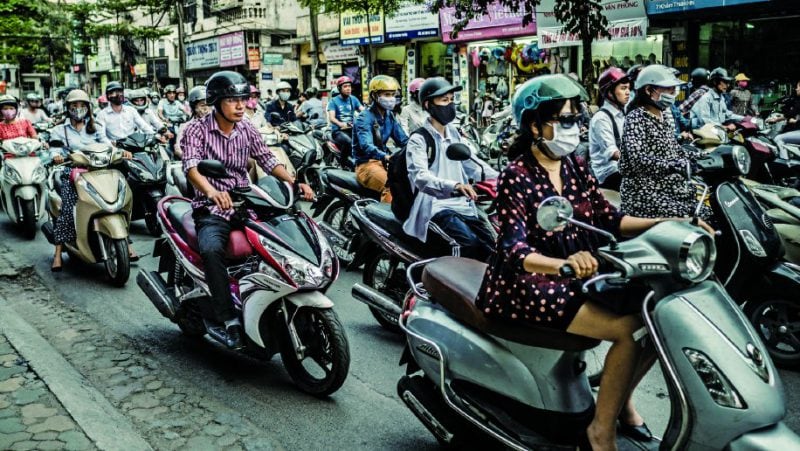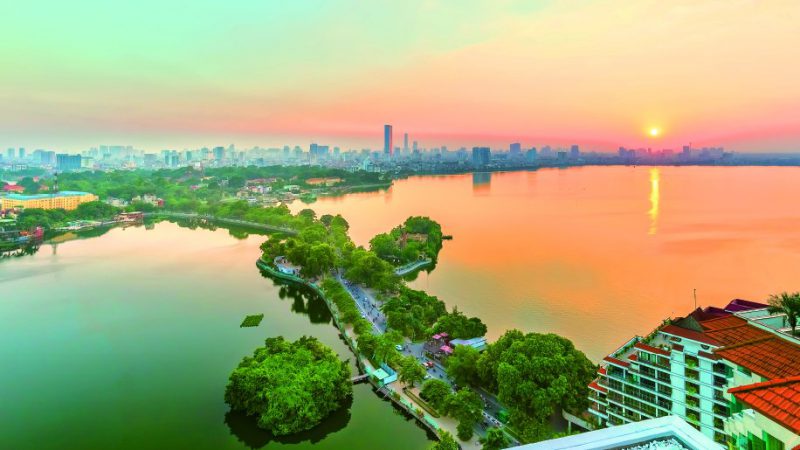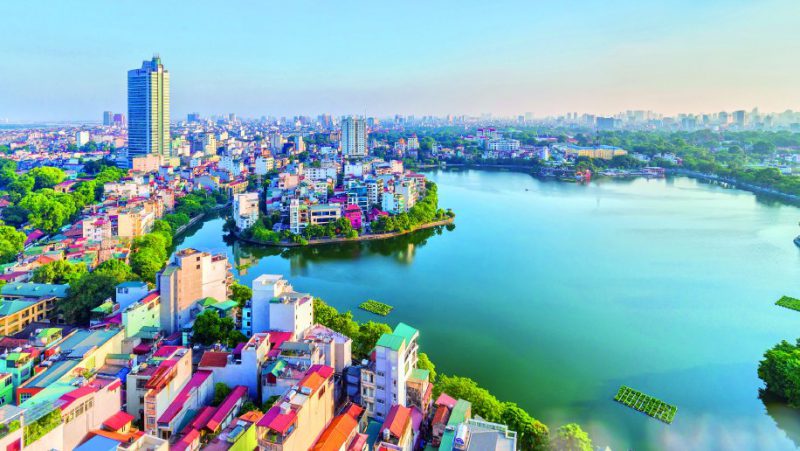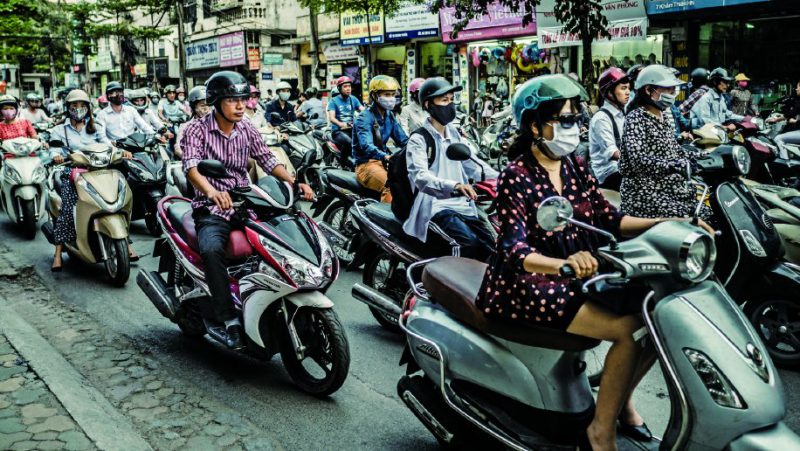Hanoi’s Rise
Vietnam’s capital brims with a youthful, optimistic energy as the country’s economy surges ahead
November 30, 2019


When veteran Hanoi-based lawyer Tony Foster went to his office during the last week of February, he had to make his way past machine gun-toting Vietnamese and North Korean guards, armored cars, and snipers manning the rooftops. It was the week of the two-day summit between Donald Trump and Kim Jong Un that, despite not ending in a favorable outcome for the US President and North Korean supreme leader, drew the attention of the international community to Vietnam’s capital.
“Our office is right next to where Kim was staying, so it was a hell of an inconvenience because we were told originally we were not going to be able to go to the office for three days – but we complained and got special passes,” says Foster, a partner at Magic Circle firm Freshfields Bruckhaus Deringer.
The summit may have been a temporary inconvenience for those working in the area, but it has done wonders for Hanoi’s standing on the global stage, showing that Vietnam and its capital city can be relevant in international politics and economics, according to Filippo Bortoletti, deputy manager of Dezan Shira & Associates’ international business advisory in Hanoi. “Even if in that meeting nothing happened specifically, still the fact that they met in Hanoi is significant. It had a big impact, maybe not on Vietnamese people, but on how foreign people perceive Vietnam,” he says.
But those already living and working in Hanoi, whether locals or foreigners, didn’t need the summit to know that their city, where an incredible 39.8 percent of the population is below 24 years old, is on an exciting economic growth trajectory. First-time visitors to Hanoi cannot fail to notice the buzzing atmosphere of youthful optimism that pervades the city.
While Ho Chi Minh City (commonly called Saigon) is widely regarded as the business capital of Vietnam, Hanoi gives visitors more of a flavor of the “real” Vietnam and a more relaxed environment, while still offering tremendous business opportunities.
“When I first came here from Saigon, I’d been forewarned by a lot of my ex-colleagues that when you come to Hanoi it’s not just another city in Vietnam; you will feel like you’re in a different country,” says Humayoon (Tom) Shaikhzadeh, general manager of the Oakwood Residence Hanoi.
“If you’re looking for that high-paced, energetic lifestyle, then compared with Saigon it’s wanting, but on the other hand if you want to engage more with Vietnamese culture, then of course this is the place to be.”
Average gross regional domestic product (GRDP) growth between 2016 and 2018 was 7.36 percent, whilst GRDP per capita reached 116 million dong (more than $5,000) during that period. The unemployment rate was only 2.17 percent in the first quarter of this year.
This has been partly driven by enthusiastic investment from foreign companies, mostly from the Asia-Pacific region. “In Hanoi, there’s a huge amount of Japanese and Korean manufacturing investment,” says Foster of Freshfields. “Samsung, just as an example, has invested billions of dollars in smartphone factories. The Japanese have all sorts of manufacturing operations in Hanoi in the north. There’s an industrial zone that goes through from Hanoi to Hai Phong and it’s full of factories, often Asian owned,” he notes.
“And if you take a flight – which I did actually last October in a seaplane – you fly fairly low and you see the extent of the investment. Even I was surprised.”
Samsung is indeed a prime example of this. The Korean chaebol is in the process of building its R&D center in Hanoi which, once completed, will employ 3,000 people and become the largest of its kind in Southeast Asia, according to the Hanoi Times.
Also, in July, Samsung SDS became the largest shareholder of Vietnamese IT services company CMC Corporation. Samsung plans to utilize the Hanoi-based company as a base to develop software in Southeast Asia.
“The biggest employer at a private level in Vietnam is Samsung, and that’s because they employ a lot of factory workers,” says Hao Tran, co-founder and CEO of Vietcetera, a bilingual Vietnamese and English media company based in Ho Chi Minh City.
“The number one single export from Vietnam is smartphone parts – shipping them to Korea for assembly. Where people were [previously] mostly on the lower skilled manufacturing side, the trend now is for people making cars, smartphone parts and all that fancy stuff.”
Much of that manufacturing is done in high-tech industrial parks. Hanoi aims to build 30 new industrial clusters by the end of 2019, according to the state-run Vietnam News Agency, and the city is now home to 70 industrial clusters covering 3,300 acres and having about 3,100 operational production facilities.
By 2020, there will be 138 industrial clusters with an area of more than 6,481 acres in the city, according to a report by Dezan Shira.
Industrial complexes in the northern districts prioritize electronics and IT, engineering, automobiles, textile, pharmaceuticals and cosmetics, according to a Dezan Shira report.
Down south, the focus is on the biological industry for high-tech farming and supporting industries, while in the western areas the focus is on bio-industry for agriculture, high tech industrial production, construction materials and high-end furniture production.
“Many high tech industrial parks there are flourishing, with companies from Japan and Korea producing electronics and telecommunications equipment,” says Thomas Joseph Treutler, managing director of the Hanoi and Ho Chi Minh offices of law firm Tilleke & Gibbins. “Many people working at these industrial parks live in Hanoi and travel to the industrial parks each day for work.”
Hao Tran says that “the country is definitely moving towards services rather than products or manufacturing, but in the grand scheme of things Vietnam is still about agriculture and lower skilled manufacturing.”
Hanoi also has a nascent start-up culture. Duong Do Son, founder and CEO of Toong, a co-working space provider that began operations in August 2015 and now has three locations in Hanoi and two upcoming, says it took time for Vietnamese to come around to the benefits of co-working spaces over traditional working spaces, but that since 2016 there has been a “co-working wave” and the market has witnessed the impressive development of co-working spaces in Hanoi.
When Toong began operations, setting up a co-working space was regarded as a “far-fetched idea” in Vietnam, particularly since the market had recently witnessed the shutdown of several co-working spaces.
“Thus, we were overwhelmed with doubts, ridicules, criticism. Even the most optimistic person predicted that we could not last more than three months. During the first few months, we only had a handful of short-term customers and day trippers,” Duong says. But Duong didn’t give up.
He adds: “It took us quite a long time to educate the market about the concept of co-working space and its advantages over traditional working space.”
The Changing Face of the City
Economic growth invariably alters the face of a city. Just look at China, where coastal metropolises in particular have metamorphosed into economic powerhouses over just a couple of decades.
The pace of change in Hanoi is similarly stark, though unlike in Chinese cities, where a new skyscraper seems to pop up every week, construction here is a little more pedestrian. As I’m checking out of the Pan Pacific Hanoi, opposite the hotel’s entrance the skeleton of a half-built skyscraper looms over us. The 16-story building was begun in November 2010 by Hanoi Housing Development and Investment Corporation, according to Vietnamese online news website Dan Tri. But the building now sits abandoned, rusting and overgrown with grass and moss.
Ken Atkinson, executive chairman of Grant Thornton Vietnam, says the Vietnamese government’s style is different to that of the Chinese government. “Once the government approves something in China, they just steam ahead and do it, whereas here it’s still driven by consensus,” he says.
Construction delays aside, Foster of Freshfields has witnessed massive changes in the city. He came to Hanoi in 1992 when the US embargo was lifted. “Occasionally, you catch yourself thinking: ‘Was I really here, or am I in a different place?’ – it’s not comparable at all,” he says.
“They’re in the process of digging into the foundations of a building they’ve torn down next to us in order to build the HQ of a bank, and just a block away I’m looking at another construction site where they’ve just torn down a lovely colonial building and I’m not sure what’s going to go in there – probably another tower,” he says sardonically.
Foster may lament the changing face of the city, but he understands well its necessity for economic growth. “All this construction is changing the fabric of the city, so it’s not as charming as it used to be, which is quite sad, but you can understand it,” he says.
Hanoi is developing so quickly that some streets are being constructed before they can be officially named. Local residents are taking it upon themselves to (illegally) name the streets themselves, says Vietnam News.
 A Growing Middle Class
A Growing Middle Class
While Hanoi’s old-time charm may be being partly eroded by development, those who visit cannot fail to feel the infectious sense of optimism among Vietnamese, especially those who have gained a toehold in the burgeoning middle class and are benefiting from the rapid economic growth.
“Generally in Vietnam there’s an emergence of – I don’t like to call it Western – but there’s an acknowledgment of a taste for brands and new experiences that’s driving these consumption patterns, and Vietnamese people are earning more money than ever and are able to afford these things,” says Hao Tran of Vietcetera.
There are now at least 15 shopping malls in the city, notable examples being Vinhomes Times City, which boasts its own aquarium, and the Aeon Mall in Long Bien, which with its plethora of luxury brand stores wouldn’t look out of place in Hong Kong or Singapore. Additionally, Hanoi has nearly 20 international schools. You’ll also find supermarkets stocked with Japanese and Korean goods to feed the nouveau riche. “I have a Vietnamese girlfriend and if we are at the supermarket we choose the Japanese product, even if it’s more expensive,” says Dezan Shira’s Borotelli. “You can’t argue with them. They just think the Japanese product is the best.”
Foreign fashion brands are fast entering the Vietnamese market too. “Uniqlo is launching in Vietnam for the first time in October – Ho Chi Minh City first and Hanoi will follow after,” says Hao Tran. “They will go nuts over Uniqlo. H&M opened a year ago to a lot of fanfare, and Zara was before that.”
The rise of middle-class consumer culture alongside a working class still living on low wages makes for some strange contrasts in price points. For instance, I found myself paying over $10 for a cocktail in a trendy Old Quarter speakeasy, then afterwards slurping down a bowl of roadside [ital] pho [end ital] for about 75 cents.
“When I first moved back to Vietnam, my colleagues mocked me for living a luxury lifestyle because I would grab a 90,000 dong ($3) Starbucks coffee every day before work rather than a more local coffee for around 25,000 dong,” says Henry Vo, a Vietnamese who grew up in the UK but returned to Hanoi this year to work for start-up airline Bamboo Airways.
Hanoi’s middle class has enjoyed steady growth since the US-Vietnam embargo was lifted in 1994.
“At that time, the bicycle was a primary means of transportation. Then, step by step, more and more families had motor scooters. Now, many people, not just the wealthiest, are buying cars,” says Treutler of Tilleke & Gibbins.
“People’s income has increased a lot, and people have the means to travel a lot on weekends – checking out Vietnam’s fantastic seaside and mountain resorts, or visiting neighboring countries. The value of real estate has grown a lot in the past 25 years – thus, many local Hanoians have done very well in the real-estate market and obtain extra income by renting out some properties. Additionally, back in the 1990s, most people you met would be working for a government agency and it would be rarer to meet someone working in private industry. Now, that is no longer the case.”
 A City of Bikers
A City of Bikers
So if you’re visiting Hanoi for business and want to take in as much of this impressive development as quickly as possible, what’s the best way to do it? As long as your life insurance policy is up to date and you’ve got a taste for adventure, it’s without question on the back of a motorcycle.
Cruising Hanoi’s streets on the back of a Vespa Sprint Notte on a Sunday afternoon with Henry Vo, the expat returnee, the notion hit me that it sure beats the indignity of being rammed into an overcrowded subway train, everyone staring down at their mobile phones. We share the road with rebellious bikers pulling wheelies in the middle of the highway, young couples engaging in public displays of affection while riding, men with propane gas canisters attached precariously to the sides of their bikes – everyone deftly avoiding each other, including the taxi drivers watching television whilst driving.
It couldn’t be described as exactly safe (though most Hanoians will insist it is), but if you’re brave enough, this is the only way to see Hanoi like a local. Pretty much everyone in the city rides a motorbike, whether driving themselves, being driven by a friend or partner, or hailing a motorbike taxi through the Grab app.
The motorbikes are an evolution from the bicycles that flooded the city in the late 1980s and 90s. “If you stand on a street corner you’ll see 500 motorbikes; in 1990 you would have seen 500 bicycles – that’s the difference,” says Antony Slewka, director of sales and marketing at the Metropole Hanoi, the hotel where Trump and Kim had their summit meeting.
The future of Hanoi’s transportation system – if the frenzy of motorbikes interspersed with a few cars and the occasional bus can be called a “system” – is uncertain. It could go the way of Beijing, where the middle class all start buying cars and the roads get clogged up, or people might cling to their bikes because of their relative speed over cars. Or the upcoming but delayed subway might be a raving success, allowing the city to become more like Singapore or Hong Kong.
“Frankly, I’m looking forward to the subway because it’s a better way of moving, but I’m not confident it will be finished soon,” says Dezan Shira’s Bortoletti. “This segment” – he points to a portion of the subway under construction just outside the Highlands Coffee shop on the corner of Le Duan Street and Tran Hung Dao Street where we are relaxing – “they planned to finish in 15 months. They started two weeks ago. Frankly, I don’t think they will finish in one year. It will take some time.”
Says Grant Thornton’s Atkinson, “With the metro lines being developed and better public transport, it should become more organized, and once there’s adequate public transport they’ll start restricting traffic into the main areas. It’s going to be hard to implement because people have become so used to having scooters and being able to drive them right from where they’ve been to their living rooms at home – which is actually where they park them,” he explains. “It’s going to be a lifestyle change for a lot of people.”
Cruising a loop around the West Lake, the wind in our faces as we pass Hanoians, out-of-towners and foreigners alike out on their motorbikes for a Sunday joyride, some stopping for a cool lakeside beer, one can’t help but feel that something would be lost if this city’s transportation network became more like that of Hong Kong or Singapore.
“It’s quite fun [riding a motorbike],” admits Tony Foster. “Most of the drivers are actually incredibly careful and I’m amazed how few accidents there have been. I cycle around the city and it’s quite fun once you know the rules of the road – it does give you a little adrenaline, I suppose.”




